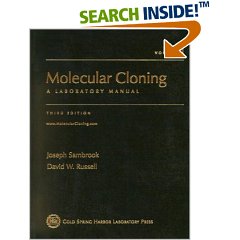Chapter 1. Plasmids and Their Usefulness in Molecular Cloning
Chapter 2. Bacteriophage lambda and Its Vectors
Chapter 3. Working with Bacteriophage M13 Vectors
Chapter 4. Working with High-capacity Vectors
Chapter 5. Gel Electrophoresis of DNA and Pulsed-field Agarose Gel
Electrophoresis
Chapter 6. Preparation and Analysis of Eukaryotic Genomic DNA
Chapter 7. Extraction, Purification, and Analysis of mRNA from
Eukaryotic Cells
Chapter 8. In vitro Amplification of DNA by the Polymerase Chain
Reaction
Chapter 9. Preparation of Radiolabeled DNA and RNA Probes
Chapter 10. Working with Synthetic Oligonucleotide Probes
Chapter 11. Preparation of cDNA Libraries and Gene Identification
Chapter 12. DNA Sequencing
Chapter 13. Mutagenesis
Chapter 14. Screening Expression Libraries
Chapter 15. Expression of Cloned Genes in Escherichia coli
Book Description
The first two editions of this manual have been mainstays of
molecular biology for nearly twenty years, with an unrivalled
reputation for reliability, accuracy, and clarity.
In this new edition, authors Joe Sambrook and David Russell have
completely updated the book, revising every protocol and adding a
mass of new material, to broaden its scope and maintain its
unbeatable value for studies in genetics, molecular cell biology,
developmental biology, microbiology, neuroscience, and immunology.
Handsomely redesigned and presented in new bindings of proven
durability, this three-volume work is essential for everyone using
today’s biomolecular techniques.
The opening chapters describe essential techniques, some well-
established, some new, that are used every day in the best
laboratories for isolating, analyzing and cloning DNA molecules, both
large and small.
These are followed by chapters on cDNA cloning and exon trapping,
amplification of DNA, generation and use of nucleic acid probes,
mutagenesis, and DNA sequencing.
The concluding chapters deal with methods to screen expression
libraries, express cloned genes in both prokaryotes and eukaryotic
cells, analyze transcripts and proteins, and detect protein-protein
interactions.
The Appendix is a compendium of reagents, vectors, media, technical
suppliers, kits, electronic resources and other essential
information.
As in earlier editions, this is the only manual that explains how to
achieve success in cloning and provides a wealth of information about
why techniques work, how they were first developed, and how they have
evolved.
Book Info
Peter MacCallum Cancer Institute, Melbourne, Australia. Updated text
includes revised protocols and new material for students in genetics,
molecular cell biology, developmental biology, microbiology,
neuroscience, and immunology. Describes techniques, cDNA cloning and
more. Hardcover, softcover also available. DNLM: Cloning, Molecular--
Laboratory Manuals.


